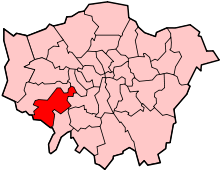Fulwell, London
Fulwell is a neighbourhood in the historic County of Middlesex and the London Borough of Richmond upon Thames in the vicinity of South West Twickenham and North West Teddington.[2] The name was first recorded in the fifteenth century and is thought to derive from 'Foul Well'.[3]
| Fulwell | |
|---|---|
 Fulwell Location within Greater London | |
| Population | 10,131 (2011 Census. Fulwell and Hampton Hill Ward)[1] |
| OS grid reference | TQ149719 |
| London borough | |
| Ceremonial county | Greater London |
| Region | |
| Country | England |
| Sovereign state | United Kingdom |
| Post town | TWICKENHAM TEDDINGTON HAMPTON |
| Postcode district | TW2 TW11 TW12 |
| Dialling code | 020 |
| Police | Metropolitan |
| Fire | London |
| Ambulance | London |
| UK Parliament | |
| London Assembly | |
The area does not have a specific political or postcode boundary, but references survive as part of a local electoral ward name, Fulwell and Hampton Hill,[4] and in the names of Fulwell railway station, Fulwell Golf Course, Fulwell bus garage. It is also part of two local street names, Fulwell Park Avenue and Fulwell Road,[2] and is referenced colloquially by local residents.[5]
In 2009, a proposal to remove the name Fulwell from the local political boundary map was rejected.[6]
The largely residential area has an Anglican parish church, St Michael's, which, after a 15 year closure, was reopened for worship in 2014 and regained parish status in 2019.
History
Historically Fulwell formed the southern extent of Hounslow Heath and the underlying Taplow gravel that defined it. A reference to assarts at Fulwell dating from around 1200 are amongst the earliest records of the name.[7] The area was progressively enclosed for agriculture and increasingly urbanised since the Victorian period of metropolitan expansion of outer London.
Fulwell bus depot was built in 1902 as a hub for trams and trolley cars as well as buses.[8]
Fulwell Lodge and Fulwell Park
To the west of the common land and to the north of the Staines Road south-west of Twickenham stood a house; Fulwell Lodge. Formerly known as Yorke Farm it dated from the early 17th century.[9][10] In 1871 Charles James Freake, a London property developer, purchased Fulwell Lodge and the surrounding estate. The boundary extended south from the A316 Chertsey Road and River Crane, included Twickenham Green and what became Strawberry Hill Golf Course, the area west along the Shepperton Branch Line encompassing what is now Fulwell Golf Course and returned north along the A312 Uxbridge Road to the A316. Freake named the area Fulwell Park.[11] After Freake's death in 1884 the estate passed to his wife and, on her death in 1900, was held by Freake Estates until 1910. The exiled King Manuel II of Portugal acquired the estate and lived at Fulwell Lodge from after his marriage in 1913 until his death in 1932.[9] The lodge was subsequently purchased by Wates, demolished and the surrounding land between the Staines Road and River Crane redeveloped for housing. The Portuguese connection was marked in road names such as Manoel Road, Lisbon Avenue, Augusta Road and Portugal Gardens.[12]
Nearest places
References
- "Richmond Ward population 2011". Neighbourhood Statistics. Office for National Statistics. Retrieved 11 October 2016.
- "Fulwell, London". Google Maps. Retrieved 16 October 2019.
- Willey, Russ (26 October 2007). Chambers London Gazeteer (First ed.). p. 187. ISBN 978-0550103260. Retrieved 16 October 2019.
- "Ward map of the Borough". London Borough of Richmond upon Thames. Retrieved 14 April 2019.
- "Every Lidl Helps? Supermarket plan for Fulwell". Twickerati. Word Press. Retrieved 16 October 2019.
- Kilvington, Joanna (24 October 2009). "Richmond ward name change plan gets lukewarm reception". Richmond and Twickenham Times. Retrieved 16 October 2019.
- Reynolds, Susan, ed. (1962). "Heston and Isleworth: Hounslow Heath". A History of the County of Middlesex: Volume 3: Shepperton, Staines, Stanwell, Sunbury, Teddington, Heston and Isleworth, Twickenham, Cowley, Cranford, West Drayton, Greenford, Hanwell, Harefield and Harlington. Institute of Historical Research. pp. 94–96. Retrieved 26 November 2014.
- "Fulwell Depot". Twickenham Museum. Retrieved 14 October 2019.
- "Fulwell Lodge". Twickenham Museum. Archived from the original on 1 December 2014. Retrieved 24 November 2014.
- Reynolds, Susan, ed. (1962). "Twickenham: Introduction". A History of the County of Middlesex: Volume 3: Shepperton, Staines, Stanwell, Sunbury, Teddington, Heston and Isleworth, Twickenham, Cowley, Cranford, West Drayton, Greenford, Hanwell, Harefield and Harlington. Institute of Historical Research. pp. 139–147. Retrieved 25 November 2014.
- Watson, Martin. "Fulwell Park". Retrieved 24 November 2014.
- "Other Major Houses in Twickenham & Whitton". Twickenham Museum. Archived from the original on 1 December 2014. Retrieved 24 November 2014.
External links
- Twickenham Museum Hampton & Teddington Past by John Sheaf and Ken Howe
- Hidden London: Fulwell, Richmond upon Thames
[[Category:Places in historic Middlesex
